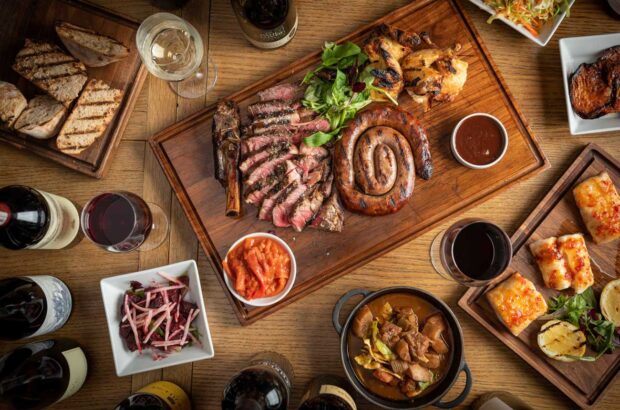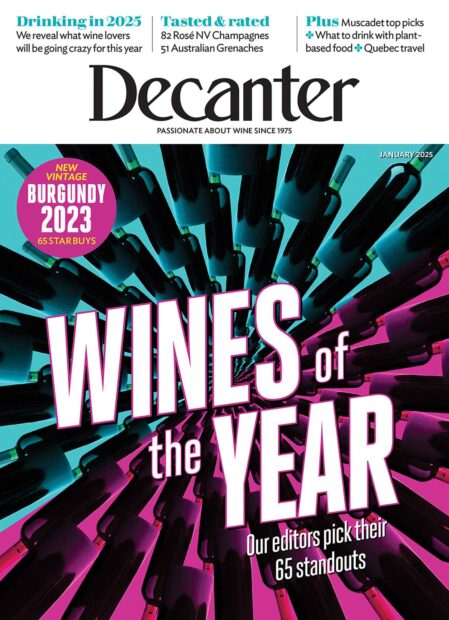In search of perfection, three Tuscan winemakers turned to eminent Bordelais consultant Professor Yves Glories. CARLA CAPALBO looks at what happened next.
Framed by the villa window, a row of plumed cypresses fans across the May-green vineyards. A picture-postcard scene, but the atmosphere in the tasting room is anything but relaxed. The first four samples of Sangiovese have been poured. The Tuscan winery owner, cellar master and agronomist study the wines, but their thoughts are on the authoritative, grey-haired man who has flown in for the tasting. He takes a sniff, lowers the glass a moment, sniffs again. He sips and swooshes. Spits. They wait. ‘Ça, c’est bon!’ Sighs of relief all round…. It wasn’t always so. The man in question is a Frenchman. Professor Yves Glories, the doyen of Bordeaux University’s legendary oenology department, and consultant to several premier cru estates, including Châteaux Margaux and Haut-Brion. His critiques, on his first visits to the three Tuscan wineries for which he now acts as consultant, were far from encouraging. ‘In the early days, it was brutal,’ recalls Giancarlo Pacenti, of the Siro Pacenti winery in Montalcino.
‘We had to practically start again from scratch,’ says Emilia Nardi, owner of the 80ha (hectare) Montalcino estate, Tenute Silvio Nardi. ‘True, true,’ confirms Giulio Caporali, manager of the Valdipiatta winery at Montepulciano. ‘But if we were geared to have a baronial rapport with a person of his status, we found instead a down-to-earth man with an impish sense of humour, with whom we have made great friends.’ After seven years’ hard toil, the results are starting to show. All three estates won coveted Tre Bicchieri awards in the 2003 Gambero Rosso Italian wine guide.
The wines of Bordeaux have long been a source of inspiration to forward-thinking Tuscan winemakers – after all, Sassicaia was created in their image in the 1960s. In spite of a healthy dose of nationalistic chauvinism when it comes to food and wine, the consensus in Italian wine circles is that the French do know how to use their barriques. Indeed, they are seen to have 100 years’ head start at it. But, until recently, few Italian winery owners have taken steps to narrow that advantage.
https://www.decanter.com/premium/sassicaia-wines-vertical-tasting-384336/
French influence
In 1996, Giancarlo Pacenti and Emilia Nardi were on the board of the Brunello di Montalcino Consortium when they attended a course on using barriques at Bordeaux University. ‘Barriques were fairly common in Italy then,’ explains Nardi, ‘but frankly, most Italian oenologists were quite approximate in their knowledge of them. I felt it wasn’t worth using this expensive tool badly. I also knew that, despite being aged in barriques, French wines had less wood to their taste than Italian wines.’ For the cost of just three barriques, they took a comprehensive course, and were impressed by the tuition. They also admired Professor Glories and his methods. They plucked up the courage and asked him to collaborate with them.
‘I accepted for a very simple reason,’ Glories says. ‘I had a little knowledge of Sangiovese, and a little of Chianti. But you could say I knew Sangiovese by its cousin, the Corsican grape, Nielluccio – which is from the same zone. I felt it was an interesting variety to study as it presents a colouring matter that is relatively difficult to extract, and requires particular conditions to mature well.’
Glories was keen to become more familiar with Brunello and Vino Nobile, and pleased to discover a group of people so keen to understand Sangiovese’s evolution. ‘If they’d said they had Merlot and Cabernet, I probably wouldn’t have come,’ he adds, laughing. And so the adventure began. The three winery owners, all friends, each had their own reasons for embarking upon the project, but they shared a common desire to invest in the future, whatever the cost in the present. ‘Sangiovese is a great grape,’ says Caporali. ‘But taming its tannins has always been a problem. Some people resolve this – officially or otherwise – by adding Merlot. We chose instead to work in the vineyard and the cellar to reduce Sangiovese’s tannins, while leaving its aromatic faculties intact.’
Much overhauling was needed: ailing vineyards were ripped out and replanted; vines were pruned to very low yields; cellars were modernised and kept scrupulously clean; small French barrels were used. The two Montalcino wineries were accused of being ‘anti-traditionalist’.
‘Glories has 40 years of experience,’ says Pacenti, whose Brunello and Rosso di Montalcino are now firmly established at the apex of Italian wines. ‘He is able to taste a wine, and from that tasting explain what its defects are and what has caused them. This is invaluable.’ A chemist by training, Glories is as comfortable talking soil samples as he is analysing colour molecules, or discussing the pros and cons of vinification tanks.
‘At the outset, to a greater or lesser degree, I found faults in all stages, from the vineyards to the cellars,’ Glories confirms. ‘Some of the vinification techniques were practically prehistoric. But these things can be corrected, and Montalcino offers a fascinating terroir for Sangiovese, where it can be extremely expressive.’ Montalcino is characterised by diverse growing zones, and Sangiovese behaves differently upon each. The hotter vineyards to the south of the medieval hill town produce wines with body and richness, whereas wines from the cooler, northern slopes are often more perfumed and elegant.
With a true scientist’s rigour, Glories quickly set up methods for researching these territorial differences, as he did at Montepulciano. Large vineyards were subdivided into smaller parcels whose characteristics differed; these plots were then tracked – and ultimately vinified – separately. Databases were formed on such topics as soil and climatic variations, harvesting times, and maturity levels of the Sangiovese.
https://www.decanter.com/wine-travel/italy/montepulciano-wine-tour-wineries-and-restaurants-372919/
Adapting to terroir
‘It was interesting to see the differences in Sangiovese’s aromas and tannins as a result of its maturing conditions and changing terroirs,’ Glories says. ‘Like Merlot, it is a delicate grape – before reaching optimal maturity, it remains vegetal in character. Then it is only aromatically interesting for a short time before passing quickly into overripeness… confiture, chocolat! So you have to know exactly when to pick.’
All of which leads us to a central practice of Glories’ oenology. Pacenti explains: ‘For a winemaker, one of the trickiest problems as you approach the harvest is deciding when to pick the grapes. Traditionally, a series of basic analyses is done to test the grapes’ technical maturation: their sugar and acidity levels, and their pH. And that’s about it. When there is a good percentage of sugars and the acidity has dropped enough, you pick. Here at Montalcino, the old folk also taught us to crush a grape between our fingers and see how much colour ran out: “If it stains, pick it,” was their dictum. So we did.’ In the 1990s, working in the Bordeaux area, Glories developed a method known as ‘phenolic maturation,’ which took the process a stage further. The fundamental components of red grapes are the polyphenols in the skins, the tannins that come from the pips, and the colouring substances, or anthocyanins.
‘Glories’ system allows us to determine which point in the grapes’ evolution these components have reached,’ continues Pacenti. ‘This, in turn, enables us to extract them in a positive manner, without any unpleasant sensations remaining in the wine – due to unripe tannins, for instance.’
Monitoring of such factors begins around a month before the probable harvest date, at weekly intervals. A mini-harvest of 100 grapes is crushed, and the resulting liquid is tested with specialised equipment. ‘If a vineyard is particularly good then the two maturation periods may coincide,’ continues Pacenti. ‘But this doesn’t always happen. You might have grapes that are at a projected 14% alcohol at the beginning of September, but are still green from the point of view of the maturation of the polyphenols. Clearly, you will never obtain a balanced wine from such grapes.’ Luckily, Sangiovese is so well adapted to the terroirs of Montalcino that extreme disparities of this kind don’t occur there. But differences exist between its zones.
‘Since each patch of Sangiovese has a unique terroir, they mature at different stages,’ explains Nardi. ‘And this has enabled us to build up a personal “identity card” for each parcel of our vineyards.’ Guided by the analysis results, Glories then tailors a vinification programme for each lot, to extract the best characteristics of the grape in each particular growing condition.
‘This method is not necessarily a way to establish a definite harvesting date,’ says Glories. ‘It is rather a means of knowing the grapes’ condition at the moment they are picked, which allows us to use all our vinification technology to obtain colour, structure, aromas and balance. The other very interesting thing is that, thanks to our tests, we can foresee the composition that each batch of wine will have.’
The final stage takes place in a group tasting session at which Glories is always present. About 12 months after the harvest, the batches are ready to be assembled into the finished wine. Pacenti explains: ‘In France they are specialised at blending different grape varieties, but here we do it by putting together Sangiovese from different zones. The theory is that with four or five different glasses of wine in front of you, by blending them in varying degrees, you can create a wine whose sum is greater than any of its parts. But you must be skilled. For example, you might have a perfumed wine, whose entry is good, but that lacks a bit of length. Mix it with one less aromatic, but longer, and you may obtain a wine of far greater complexity.’
Clearly, all of this requires cellars with adaptable equipment for both vinification and ageing, and a wide selection of excellent French barriques. It also requires someone in the cellar capable of tasting the wines on a daily basis, and experienced enough to guide them through each phase. Glories visits Tuscany twice a year, and the wineries take him samples to taste in two other periods. Paolo Vagaggini, the oenologist who is collaborating on this project, handles the analyses in his Tuscan laboratory. If all goes well, this set-up allows the winemakers to guarantee a consistent production of fine wines, even in less than great vintages.
Beyond that, it’s up to the grapes. As Glories says: ‘One can only make a great wine by bringing remarkable grapes to high levels of maturity.’ He should know.
Carla Capalbo lives in Italy and is author of the Food and Wine Lover’s Companion to Tuscany (£11.76, Chronicle Books).
Written by Carla Capalbo







